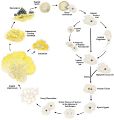Species
Physarum Policephalum is an eucaryotic organism which belongs to the class of Myxogastria. It passes a life cycle of morphologic phases, with the phase in which the multinucleate cells form a plasmodium (thin film, with visible branches) often being used for study purposes. This slime mold can be found in cool, humid, darker places, for example on rotten wood in the forest.
Images taken from: https://www.ctvnews.ca/sci-tech/strange-yellow-slime-mold-can-remember-where-it-left-food-study-says-1.5326525
https://knowledge.carolina.com/discipline/life-science/biology/the-slime-mold-physarum-polycephalum/
Growing of Physarum
To be able to use the plasmodium for projects or study purposes, bigger cultures of Physarum have to be grown.
Step 1: Preparing petri dishes:
Materials: Petri dishes, Erlenmeyer flask/pot, distilled water/tap water, powdered agar, scale
The easiest gel to make is agar-agar-medium at a ratio of 1 to 100:
| Component | Quantity | Custom Quantity |
|---|---|---|
| water | 100 ml | x |
| agar agar | 1 g | x |
- Fill the needed amount of water either into a pot or the Erlenmeyer flask
- Weigh the needed amount of powdered agar (e.g. by using some tinfoil as a dish)
- Stir the agar into the water
- Stir and heat the mixture until it's boiling (by using the stovetop or microwave) and take it off the heat before it boils over
- Pour the mixture into the petri dishes until they are max. halfway full and let them cool down until the medium has solidified
Step 3: Starting a new culture
There are two ways for starting a new culture of Physarum:
1) Using a part of an already existing culture:
- If there is already a culture available, take an oat flake with slime mold on top of it and place it in the prepared petri dish (or multiple oat flakes)
- Place new oat flakes

